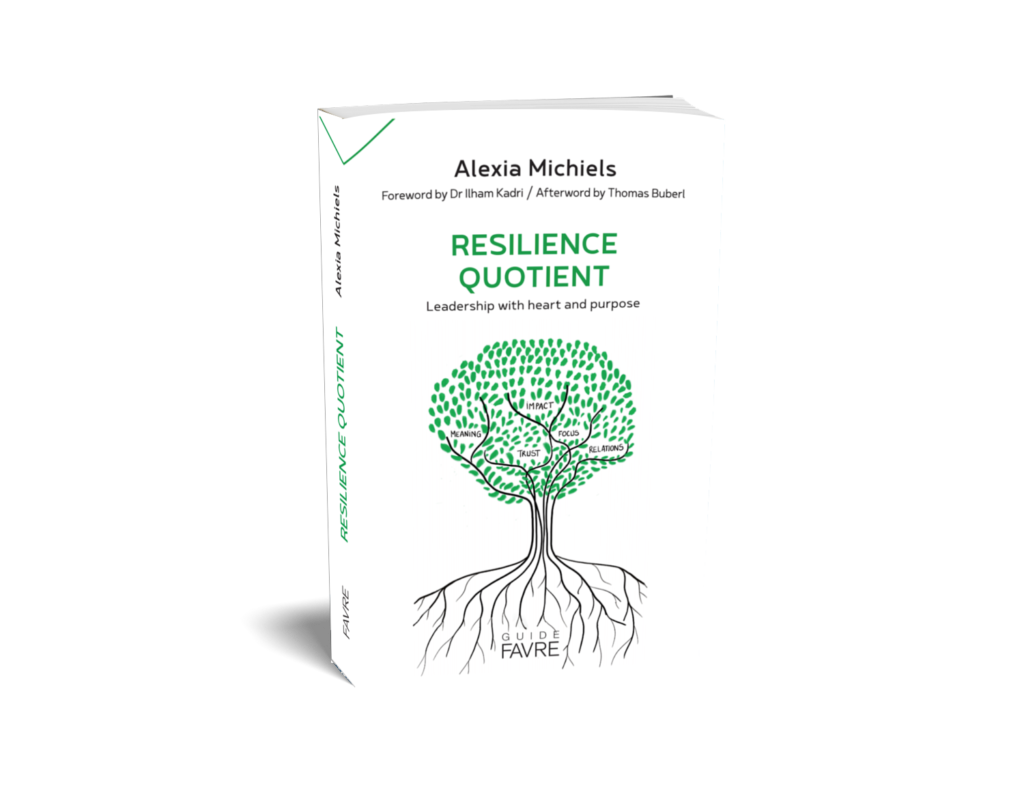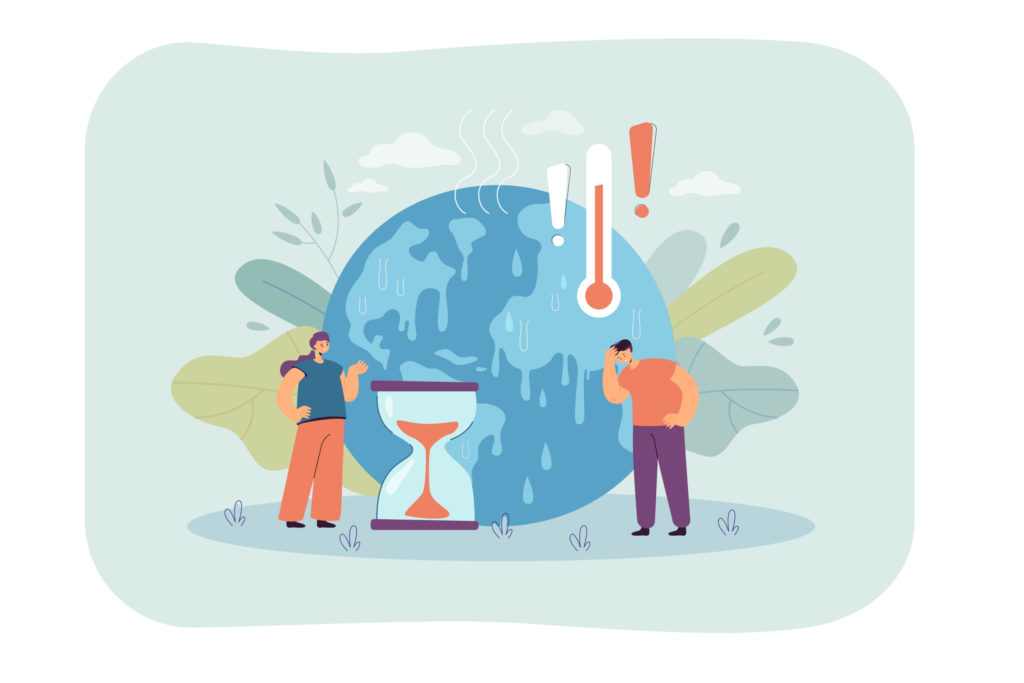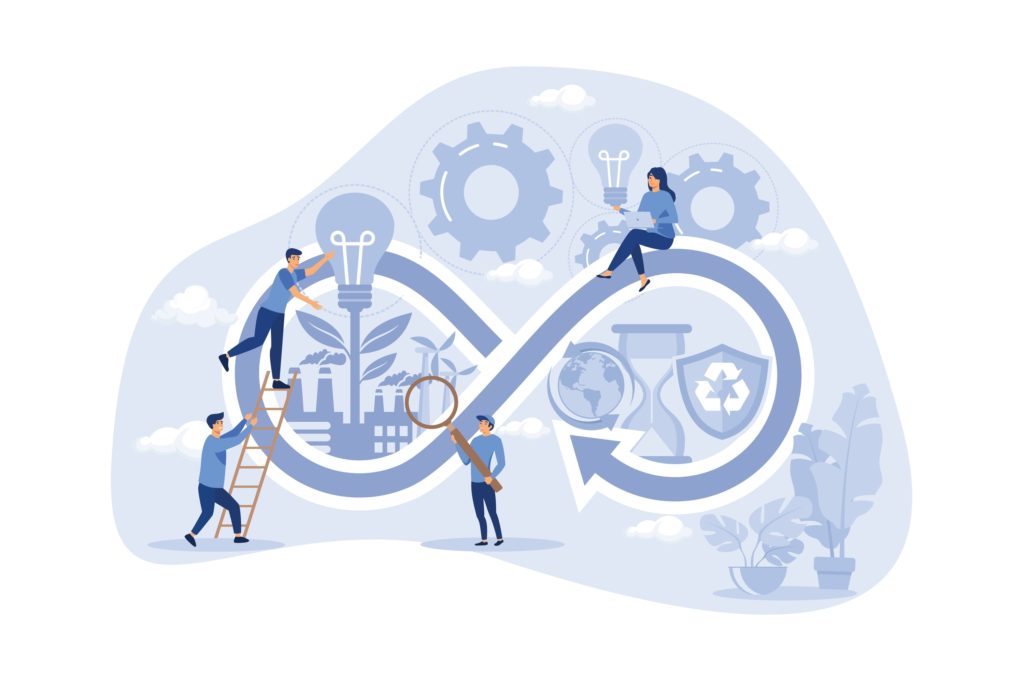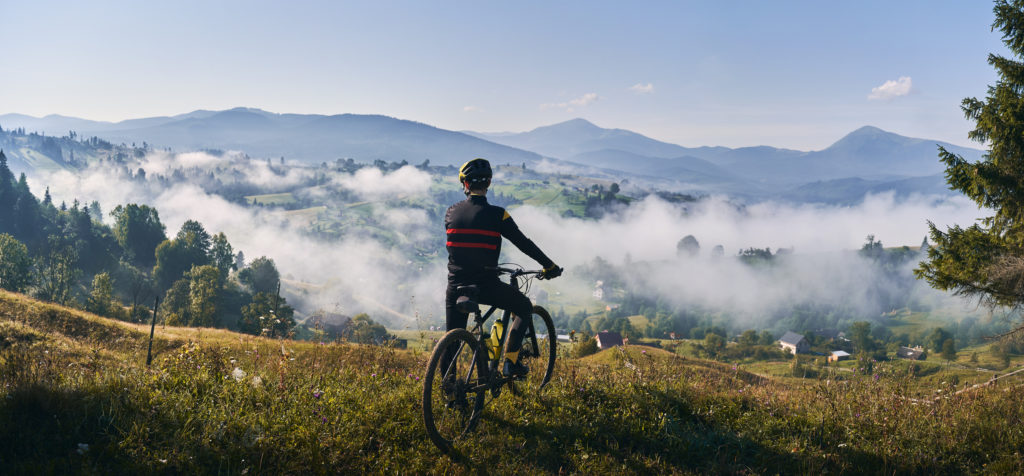
How to Improve Your Connection With Nature
Excerpt from: “Resilience Quotient” by Alexia Michiels
There are only two ways to live your life. One is as though nothing is a miracle. The other is as though everything is a miracle. – Albert Einstein

How can we not marvel at a sunset, the blue of the ocean, a lush forest, a cherry blossom tree in spring, the majesty of the mountains, the birth of a baby calf, sunflowers turning toward the light, the colors of a hummingbird, the phosphorescent light of fireflies, the ingenuity of ants or the beauty of a butterfly?
We sometimes overlook nature’s miracles, as we are so taken by our modern existence. Preoccupied with our agenda, train schedules, telephone, computer, and sales targets, we tend to forget how extraordinary planet Earth is.
Many astronauts have testified that seeing the Earth from space for the first time made them instantaneously realize just how small, fragile and precious our planet is. They called this experience the overview effect35 – a cognitive shock, a sudden state of mental clarity, that renders the need to protect this little blue dot36 clear and imperative.
In 2017, a few days before the end of the Proxima mission that took him to the International Space Station for six months, the French astronaut Thomas Pesquet shared his thoughts on the subject: “We need all this technology to get here and understand the simplicity of things: the Earth, the cosmos, life as a whole. It’s hard to understand borders, wars and hatred.”

What if we paused to reflect on the relationship we cultivate with nature as a leader, living on earth?
The resilient leader is aware of the world’s challenges and makes choices with all stakeholders in mind – employees, customers, shareholders and… the environment. How about becoming a change agent? In this chapter, I put forward a state of play so that you can take an informed look at the solutions emerging in the private sector, and I give some examples of companies that are placing environmental issues at the heart of their strategy.
As I researched and wrote this chapter, I felt hope and confidence grow. Better understanding a situation, no matter how troubling, allows for a lucid approach. The resulting clarity allows us to find the courage to make sometimes difficult choices. The many climate initiatives underway fuel my realistic optimism (as described in Chapter 3), and I hope yours as well.
What is nature?
Asking this question is not neutral. The Western worldview distinguishes between human beings and human works on the one hand, and nature on the other. In some cultures, the first peoples for example, this concept is inexistent because plants, animals and humans are included in a global sphere37. This perspective is far removed from the interpretations of classical Judeo-Christian thought, for which our species, created by God, has no place in nature but above it. Pope Francis’ Encyclical Letter, Laudato Si’38, addressed in June 2015, reconnects with the original biblical message of respect for nature39. Dedicated to environmental and social issues, and in general to the safeguarding of what he calls our Common Home, the text is based on a systemic vision of the world and calls for the reader to rethink the interactions between human beings, society and the environment. In this encyclical, Pope Francis emphasizes the interdependence between all species and the planet Earth. It is worth noting that St. Francis of Assisi (1181-1226), the inspiration for the name chosen by the Pope, is often considered the patron saint of ecologists, defender of nature and friend of animals. This is a pope whose courage and boldness – in a 2000-year-old institution not prone to innovation – is remarkable!
One surmises that in the Neolithic Age, about 10,000 years ago, when people began to settle down to farm the land, the relationship of humans with nature changed profoundly40. The hunter-gatherers, our Paleolithic ancestors, lived by hunting, fishing, and gathering. The corollary of nomadism, following herds in their migrations, was a form of asceticism. There was no incentive in accumulating excessive goods or provisions; the criterion of portability was essential. We can therefore assume that Paleolithic societies lived in a respectful relationship with other species and adaptated to their environment. This hypothesis is evidently far remote from the reality of modern society, whose foundations are based on extraction and exploitation, for the benefit of mankind.
This evolutionary vision of the Man-Nature relation includes the word nature in its external meaning (everything that is not human and/or human production). It goes without saying that our inner nature, the human nature, is part of this reflection.
Your relation to your inner nature, your personal ecosystem, influences the relationship you entertain with the outer nature.

This is why the chapters on relationship to oneself and relationship to others precede this one. In short, cultivating a healthy relationship with your inner nature tends to promote a healthier relationship with outer nature. And vice versa. Cultivating a relationship with outer nature nurtures a sense of humility, responsibility and gratitude. It’s even beneficial to your health. A fascinating study41 of the medical records of prisoners in a Michigan penitentiary in the 1970s proved that visual contact with nature was enough to provide positive effects: those who, by coincidence, were locked in a cell with a view of a natural landscape had a 24% lower risk of suffering health problems than those whose window faced a brick wall. Recent scientific advances clearly demonstrate that contact with nature is necessary for our mental health. The Japanese encourage the practice of shinrin-yoku (forest bathing), scientifically recognized for its therapeutic effects. We unconsciously find in nature what has allowed our species to survive and evolve for thousands of years. This link with nature is at the origin of the concept of biophilia “(from the Greek bio meaning “life” and philia meaning “who loves”), designating the visceral love of humans for the living.
Has our society’s evolution disconnected us from this intimate relation with nature? A highly likely hypothesis.
Connecting while distinguishing
When it comes to representing nature, two depictions dominate and are in opposition: one entirely includes humans in the universe, the other separates man and nature.
Anthropocentrism puts man at the center of the world and considers him segregated from nature. It is a dominant position vis-a-vis nature. Biocentrism is the opposite. The anthropocentric vision, whose excesses are destructive, is opposed to a vision where nature is sacred. Every living being, human or not, deserves respect and consideration. Man is no longer at the top of the hierarchy of living beings but a part of the whole and has no specific place. If every living being is entitled to respect, there would be no reason to choose the side of humans when they are threatened by other species. Biocentrism is anthropocentrism’s opposite extreme… and, as is often the case, extreme positions carry with them harmful excesses.
According to philosopher and sociologist Edgar Morin (born in 1921), either perception is a reflection of a form of laziness that aims at simplifying a complex reality. It invites to conceive uniduality42, which characterizes a simultaneous relation of implication and separation between man and nature. A question of connecting while distinguishing. Here is an arduous mental exercise for the binary mind that tends to dominate in our western culture. This perspective is closer to Taoism, a current of Chinese thought, which is based on the existence of a principle at the origin of all things (called tao) and a sense of yin-yang balances – at once distinct and connected.
Nicole Huybens43, psychosociologist, integrates the complex thought of Edgar Morin to approach the relationship between man and nature through an ecocentric vision. Ecocentrism presents a systemic approach that includes species, communities of living beings and ecosystems. This vision is based on the scientific observation that living (biotic) and non-living (a-biotic) elements interact to form a whole that has its own coherence. Protecting biodiversity, therefore, becomes a priority issue: if one species disappears, the whole ecosystem is off-balance. This imbalance affects us, living beings. By insisting on the interdependence of life forms within a complex whole, Nicole Huybens invites us to respect the laws of nature:
Contemplating the beauty of the world, thinking of it as a whole and harmonizing human behavior with the laws of nature are the pillars of the ecocentric vision.
The notion of interdependence is also present in the Gaia theory, which examines all the existing interactions within the Earth system. This theory is an evolution of the Gaia hypothesis, put forward in 1970 by the English climatologist James Lovelock (born in 1919) and the American microbiologist Lynn Margulis (1938-2011). According to this controversial hypothesis (also called the geobiochemical hypothesis), the Earth “is a dynamic physiological system which includes the biosphere, in which all living beings form a kind of super-organism – called Gaia – that self-regulates its components to promote life. However, this self-regulation capability, which preserves the conditions for life, is jeopardized by global warming. Theories based on the Gaia hypothesis present an alarming prognosis for the future of the biosphere, and therefore for the future of our species.
How to face the planetary environmental crisis? How to accelerate the necessary changes? How to move from awareness to action? And you, what do you do?
Bring your attention to the present moment to ask yourself these questions:
- When was the last time I marveled at nature?
- What feelings dominate when I am in nature?
- Are environmental issues part of my daily thinking?
- Have I ever discussed environmental issues with my team?
- If not, what is holding me back?
- If I have, how has it been perceived by most employees?
Scientific consensus, facts and figures
In the professional world, pragmatism is the order of the day. In my career, I have witnessed how facts – real and verified – are generally the basis for decisions. Let us thus assume that, as a leader, you are receptive to facts, data, and vetted information. Resilience invites lucidity; only by understanding a situation, as accurately as possible, can you decide on a strategy to rebound, change course and find new momentum. So let us open our eyes, not to be overwhelmed by despair or guilt, but on the contrary to take advantage of our influence – small or big – and choose to move in the direction of the future.
The environmental situation is alarming. The scientific consensus leaves little doubt that global warming will have dramatic consequences. The global exploitation and use of natural resources have progressed at an appalling rate since the 1950s; production methods, our lifestyles and more generally our model of society have led to massive global disruptions: global warming, ocean acidification, drop in biodiversity (on land as well as at sea). Back in 2014, the IPCC stated that greenhouse gas emissions generated by economic and population growth are responsible for these climate disruptions.
“It is now 99.9 % certain that humans are the primary cause of global warming” concludes a study published in 2018 in the journal Science44. The latest IPCC45 report published on August 9, 2021 confirms this: “Human influence on global warming is unequivocal.”

The increased awareness of this phenomenon no longer leaves room for denial. Yet, there are climate change deniers, and others merely refusing to consider that it is the result of human activities or its harmful consequences. These are the climate skeptics. It is difficult to listen to their populist, egotistical and often simplistic speeches. A recent study46 on a large sample (30 countries + 24 000 people interviewed) concludes that 8 % of the population does not believe in global warming. Even more worrying: 23 % doubt its human causes, hence our responsibility. The study’s conclusion: there is an average of 31 % climate skeptics in the world, particularly prevalent in the United States, China, Saudi Arabia, Australia and Norway!
In 2015, the Paris Agreement47 (adopted at COP21, the Paris climate conference) formalized a global response to the threat of climate change; this declaration of intent (not legally binding), signed by more than 195 countries, aims to keep the increase in global temperature by 2100 below 2°c compared to pre-industrial levels, and to continue efforts to limit it to 1.5°C. Half a degree more makes all the difference; it significantly increases the number of climate refugees, deaths, health problems caused by heat, risks of diseases such as malaria and dengue, droughts, heavy rainfall, etc.
Concretely, to achieve this goal, CO2 emissions would have to fall by 45 % by 2030. The current trend leads to a warming of more than 3°c by 2100. There is urgency! In September 2020, Chinese President Xi Jinping announced that he was aiming for carbon neutrality by 2060, which means that by that date China should not emit more greenhouse gases than it absorbs, through tree plantations or technologies to capture CO2. Other countries, such as the United Kingdom, Japan or the United States (under the presidency of Joe Biden), but also the European Union, have also committed to achieve carbon neutrality by 2050.
Ursula von der Leyen, President of the European commission, unveiled in December 2019 Europe’s ambitious environmental plan: The European Green Deal, or EGD48 (Green Deal for Europe), envisions a systemic approach based on economic growth decoupled from resource exploitation. In July 2021, an arsenal of legislative measures was announced, including the end of gasoline-powered cars and a kerosene tax in the aviation sector. The goal is a 55 % reduction in greenhouse gases by 2030, and to be the first carbon-neutral continent by 2050. This roadmap sets a course for a sustainable, equitable and inclusive economy.
Decades of economic growth have completely ignored negative externalities (social or environmental impact) and were evaluated along reductive macroeconomic indicators (GNP). The crisis is now twofold: economic gains only benefit a minority and leave too many people behind; all the while the impact of human activities on the climate and biodiversity threatens the survival of our species. More than just a responsible vision, the Green Deal for Europe includes a series of operational measures to shift the economy from an extractive to a regenerative one. The action plan is designed to promote a clean and circular economy while restoring biodiversity and reducing pollution. The European Union also provides financial support and technical assistance to help those who will be most affected by the transition to a green economy. While acknowledging the flaws or shortcomings of a Europe that we would often like to be stronger and more unified, I applaud this initiative that reveals the best side of this institution. When intelligence and creativity are put at the service of a global cause, hope is revived.
Should all these promises be kept, and according to the Climate Action Tracker49, global warming could be contained to 2.1°c by the end of the century – not far from, but above the objective of the Paris agreements. But what are promises worth in thirty or forty years from now?
The Greta Thunberg generation
In August 2018, a 15-year-old girl convinces her parents of the climate emergency and decides to raise her country’s government awareness about the issue. She settles down in front of the country’s parliament, and spends her days there brandishing a sign stating school strike for climate. Greta Thunberg, a young Swedish girl born in 2003, was unaware at the time that the movement she initiated would grow to a global dimension and mobilize young people all over the world. The Fridays for Future – demonstrations organized by young people – are quickly set up, and benefit from an immense media coverage. Greta Thunberg becomes the symbol of a whole generation of young people, aware of the issues at stake and determined to get decision-makers to move.
Invited to meet with many heads of state, speaking at multiple international conferences, including the United Nations Climate Summit in New York in 2019, Greta points the finger at the political leaders’s responsibility, who are doing too little in light of the emergency. She calls them to account with a straight face, and a fiery spirit. We remember her fierce look during the intense speech she gave at the United Nations in New York in 2018: How dare you? Greta’s direct style and anger at political inaction have earned her as much praise as criticism. Whatever one thinks of it, Greta Thunberg has been the catalyst of an unprecedented awareness, and has stimulated an extraordinary surge of commitment among the youth. The same young people who may be your employees tomorrow. The young people who are tomorrow’s leaders, and want a more responsible world. In 2019, TIME Magazine voted Greta Thurnberg “Personality of the Year”.
From nature awareness to responsibility, companies in the process
Corporate Social Responsibility, or CSR, refers to the voluntary recognition by corporations of the economic, social, environmental and ethical issues related to their activities. A company practicing CSR aims for a positive impact on society, respect for the environment, while being economically viable. This delicate balance is struck in partnership with its stakeholders, i.e. employees, customers, suppliers and shareholders. The company voluntarily implements good practices; the business model can be questioned to render it compatible with the fight against climate change or sustainable resource management. CSR is a new vision of the role of organizations and their responsibility in society. This approach is increasingly promoted, and even mandatory in certain jurisdictions, although it is optional. For example, in 2019 in France, the Pacte law (French acronym for: Action Plan for the Growth and Transformation of Companies) establishes a minimum legal base for the integration of these CSR dimensions in the conduct of business. In April 2021, the European Commission adopted the CSRD (Corporate Sustainability Reporting Directive50) proposal, which aims to harmonize CSR reporting over the next few years and extend it to more European companies with a view to facilitating investments based on ESG criteria (Environment, Social, Governance).
With our perspective of unlimited growth, we have reached unprecedented levels of resource extraction, pollution, and waste. The current state of knowledge shows how unsustainable the standard economic model is. Our view of development is flawed because the way we measure it does not take into account the negative impacts of economic activity – the so-called negative externalities, such as pollution, soil depletion or the devastating consequences of deforestation. There is no trace in conventional accounting of the cost to the environment (and therefore to society). Take the example of oil: its market price reflects the cost of extraction but does not include the cost of its manufacturing by nature – the millions of years it takes for organic matter to be transformed into oil. The case for a regenerative economy is growing.
The regenerative model, inspired by the observation of living organisms in nature, and guided by the collaboration principle rather than competition, promotes a local economy, an economy of use and a circular economy.
Some examples51 distinctly illustrate the relevance of an economy of use (also called functional economy). In Europe, for 92 % of its life time, a car is parked, thus unused; 31 % of food is wasted and office space is occupied 35-50 % of the time, even during working hours (note: these statistics were established before the pandemic). The circular economy, on the other hand, aims to reduce, repair, reuse, redistribute and recycle products that are designed with this in mind. Plastic is a good example. Thanks to innovations in cleaning, smart packaging or waste treatment, plastic waste can be drastically reduced, reused or better managed. New movements are emerging, such as Circular Economy Switzerland52, which bring together private companies and political organizations around the common goal of making the economy more circular.

While initiatives to fight global warming are multiplying, discussions around this environmental issue, whose stakes are political, social, economic, technological, sanitary and ethical, are also continuing. Apart from the climate sceptics mentioned above or the uninformed, no one can claim ignorance. Citizen mobilizations and eco-actions are multiplying: waste sorting, turning off unnecessary lights, favoring soft mobility, buying in bulk to decrease packaging waste, heating judiciously, saving water, etc. This is commendable and necessary, but obviously not sufficient. In this battle, we have to activate the tripartite – political power/citizen power/business power – to accelerate transition.
Businesses can play a leading role in this climate fight. As a leader, you can contribute to this collective effort, whatever your sphere of influence. The professional world, a breeding ground for multiple intelligences and creativity, has an important part to play in this race against time.
An increasing number of companies is making a commitment to become carbon neutral by 2050 – consuming fewer fossil fuels and offsetting what cannot be eliminated. Under the patronage of the United Nations, the UN Race to Zero53 campaign is scientifically monitoring these initiatives stemming, among others, from the business, political (cities, states, regions), financial, and academic worlds. This coalition represents 708 cities, 23 regions, more than 2,000 companies, 127 of the largest investors and 571 academic institutions. Collectively, these actors now cover 25 % of global CO2 emissions.
When large companies make structural, and structuring, decisions that are positive for the climate, the lines are moving!
The AXA Group, one of the world’s leading insurance and asset management companies, is setting an example: in 2019, AXA announced an ambitious climate strategy that includes objectives aligned with the Paris Agreement. Specifically, the group is committed to directing financial flows to investments with a warming potential below the 1.5°c limit by 2050. Operating in an economy that is very fossil fuels intensive, AXA is working with experts54 to develop measurement tools and methodologies to assess the warming potential of its assets, and make the necessary investment/divestment decisions.
In the food sector, Danone is also set to make a complete transition to a zero-carbon economy. The carbon neutrality by 2050 objective involves the entire value chain; Danone becomes responsible for the greenhouse gas emissions of the production cycle, from the farms to the billions of consumers in the world. How can it achieve this? On the one hand by reducing emissions, on the other hand by transforming agricultural practices, by eliminating deforestation from their supply chain, and finally by compensating for the remaining emissions.
Examples of companies that are taking this step abound, and they are a source of hope. They are not only multinationals or mega-organizations. Many SMEs are also run by leaders, perhaps you, who are contributing to this collective effort.
Your climate actions can inspire your team. By choosing to bike to the office instead of driving, by deciding to print only on recycled paper (or not at all), or by switching off air conditioning, you are raising awareness among your employees. When these actions are fully integrated into your strategy, you multiply the impact of your efforts. – “Small streams make big rivers”, Ovid
In England, 75 % of the population believes that business bears responsibility for protecting the environment55. In the Fall of 2021, a small earthquake could strike the UK! The country could become the first in the world to ratify a law requiring all companies to operate in a way that benefits not only shareholders but all stakeholders, including the climate! This bill (The Better Business Act) paves the way for a new paradigm: every commercial company, large or small, would be responsible for its social and environmental impact. Decisions taken must integrate this multifactorial perspective, rather than only considering the interests of shareholders – as is still far too often the case. According to this law, each company will have to share in an official report indicators related to its impact on people, on the planet and on profit. Supported by more than 500 companies (such as The Body Shop, Waitrose, Innocent or Patagonia), this bill was initiated by B Lab UK, an association bringing together the growing community of companies that have obtained B Corp certification in England.
Consider all stakeholders, including nature
Since 2006, the B Corp movement has brought together companies that want to turn business into a real force for the common good, pursuing the goal of the three Ps – integrating people, planet and profit. Validated by a rigorous questionnaire (the BIA: Benefit Impact Assessment), B Corp certification is awarded to companies that integrate social, societal, and environmental objectives into their business model and decision-making. B corps aim to be the best for the world rather than the best in the world. It’s hard not to praise that intention.
Rose Marcario, former CEO of outerwear brand Patagonia, was one of the pioneers in associating with this movement. Upon joining the company in 2008, she evaluated Patagonia’s production processes and took drastic steps to reduce its negative impact on the environment, such as eliminating waste and reducing packaging materials. She believes that the B Corp movement is essential because business is not only about shareholders, but also about responsibility to the community and to the planet. The values and aspirations of the B Corp community are embodied in a Declaration of Interdependence signed by certified companies who, recognizing the interconnection that binds us, commit to act responsibly toward all stakeholders and future generations. To become a B Corp, companies must amend their bylaws to require the board of directors to strike a balance between profit and mission. This legal structure is called the Benefit Corporation in the United States, the Società Benefit in Italy, and in France it has inspired the Société a mission.

Courageous leaders, determined to move from intention to action, have embarked their teams on this process. Nearly 4000 companies in 74 countries have been certified to date. Many of these companies are SMEs, with some multinationals actively engaged in the process. Danone has proceeded with B Corp certification for several of its entities. Ben & Jerry, a subsidiary of Unilever, is also a B corp.
With its 2500 employees worldwide, Swiss bank Lombard Odier has been a B Corp since 2019, determined to combine financial objectives with a societal mission. More than a declaration, it represents a commitment to respect sustainability criteria in their investments, and transparency in the monitoring of impact indicators. The bank promotes a circular, efficient, inclusive and clean economy.
Is this strategy a communication stunt or green washing? If you feel that way, think again. The B Corp certification, which is valid for 36 months, is only awarded after a thorough examination by independent bodies, ensuring that the necessary rating is obtained on the basis of a very demanding questionnaire of about 200 questions – the Benefit Impact Assessment mentioned above.
Can ecology be combined with profit?
Economy and ecology are often perceived as two opposing concepts. Yet they share the prefix eco (from the Greek, oikos), which refers to the management of the home. Reconciling economy and ecology is a necessity in order to unite the whole of society around current social and environmental issues.
Bertrand Piccard, one of the first to consider ecology through a profitability lens, is convinced that solving the climate crisis is possible by diffusing innovative and efficient technologies that will convince governments and companies to act. In the realm of his Solar Impulse Foundation, a panel of independent experts has evaluated over 1000 clean and profitable solutions. From software that tracks your carbon footprint to a used plastic repair system, from vertical farms to a reusable diaper washing machine, these innovations from around the world cover all sectors. Assembled in a Guide56, available online since April 2021, these verified solutions can be deployed on a large scale. In a pragmatic and practical way, this initiative aims to provide political and economic leaders with tools to achieve carbon neutrality goals.
The concrete examples and disruptive trends above generate collective awareness. This is the necessary step to accelerate the transition to a new economic model, integrating social and environmental impacts. The challenge for all of us is to take part in this transformation.
Leader-actor and nature stewardship
As human beings, we have the extraordinary capacity to make conscious choices. I often insist on this notion of conscious choice which underscores our freedom. As a consequence of the development of our consciousness, we are responsible for our actions. In its original sense, responsibility emphasizes our capacity to respond (response-ability).
Whatever your sector and company size – small store, SME or multinational – you have a role to play in the fight against global warming. The fate of future generations depends on it, as does the survival of your company in a zero-carbon economy.
The magnitude of the threat requires leaders to acknowledge their share of responsibility for the situation we face today. Leadership is thus facing a major challenge: to accelerate the transformation of companies to create an economic model in which the environment is a stakeholder. The time when the leader’s responsibility is limited to maximizing profits is over. The choice is yours: to suffer or to act?
Environmental initiatives, eco-actions, are flourishing in companies. Encouraging carpooling, consuming locally, eliminating plastic cups at the coffee machine, favoring less polluting industrial processes, are all useful. Beyond these everyday actions, today’s leaders are called upon to become activists, influencers and inspires.
As illustrated above by the Better Business Act in England, business leaders can lobby for more stringent legislation on social and environmental protection.
Companies have the power to influence government through their trade associations or chambers of commerce. By controlling the supply chain, it is up to you to require suppliers to assess their climate impact and to work with those who engage in the process. Finally, to reinforce your impact, communicating your environmental efforts is a way to inspire other leaders to take these steps.
Courage is the first of the virtues because it makes all the others possible. – Aristotle
Being a change leader requires courage and determination. It is not the easiest path as it incorporates a multifactorial reality, but it is the resilient path – one that elevates and contributes to the common good.

To nurture your commitment, sharing with others who share your beliefs, is extremely helpful. Some professional associations bring together leaders who are convinced of the urgency of transforming our economic model to a more sustainable and planet-friendly one. The Regenerative Alliance57, launched in 2020, supports leaders in the private and public sectors – across all industries – in this transition to a regenerative economy. By creating a space for peer-to-peer, expert-driven exchange, this community builds on the collective intelligence and collaboration of its members.
The transformation of the economic world is underway, accelerated by leaders who are increasingly concerned by the world’s future. In light of the current knowledge, it is up to you to consider your relationship with the environment as a dynamic opportunity for mutual enrichment. By expanding your professional responsibilities to include a social and environmental perspective, you give your leadership role a whole new scope. And suddenly, the question of the meaning of your professional activity touches your heart as a leader!
Bring your attention to the present moment and ask yourself these questions:
- When I make decisions in my daily work life, do I think about their impact on the environment?
- What could I do to be a more committed leader-actor?
- What eco-actions have I put in place in my team?
- Do we have a CSR policy?
- Do we integrate environmental impact criteria in the choice of our suppliers?
- Do I communicate regularly with my teams and the outside world about our climate commitments?
Resources:
35. F. WHITE, “The Overview Effect – Space exploration and human evolution” AIAA (1998).
- “Pale Blue Dot” is the name given by American Astronomer Carl Sagan (1934-1996) to a picture of Earth taken on February 14, 1990, from the voyager 1 space shuttle 1, at a distance of approximately 6 billion kilometers.
- P. DESCOLA, Par-delà nature et culture, Gallimard (2006).
- Encyclical Letter Laudato Si’ by the Holy Father Francis on Safeguarding the Common House, June 2015, available online: https://www.vatican.va/content/francesco/en/encyclicals/documents/papa-francesco_20150524_enciclica-laudato-si.html
- J. BASTAIRE, “L’exigence écologique chrétienne”, Études, vol. tome 403, n°9, pp. 203-211 (2005).
- J. DELORD, « L’extinction d’espèce: Histoire d’un concept & enjeux éthiques », Publications scientifiques du Museum (2010).
- H. FRUMKIN, “Beyond toxicity – human health and the natural environment”, American journal of preventive medicine, num 20, pp 234-240 (2001).
- E. MORIN, La méthode IV. Les idées: leur habitat, leur vie, leurs mœurs, leur organisation, Seuil (1991).
- N. HUYBENS, La forêt boréale, l’éco-conseil et la pensée complexe. Comprendre les humains et leurs natures pour agir dans la complexité, Éditions universitaires européennes (2010).
- C.Z. ZOU, F. J. WENTZ, S. SOLOMON, G. PALLOTTA, “Human influence on the seasonal cycle of tropospheric temperature”, Science, vol.361; n°6399 (2018).
- IPCC – Intergovernmental Panel on Climate Change.
- Obs’COP 2020: https://www.edf.fr/observatoire-international-climat-resultats/fr/2020
- COP21, « Adoption de l’Accord de Paris, Decision 1/CP.21 », Convention cadre des Nations Unies sur les changements climatiques, UNFCCC (2015).
- Obs’COP 2020: Ec.europa.eu/info/strategy/priorities-2019-2024/europe-an-green-deal_fr
- Climate Action Tracker is an independent scientific analysis that tracks government actions and progress toward achieving the Paris Agreement goals.
- https://ec.europa.eu/info/publications/210421-sustainable-finance-communication_fr#csrd
- Ellen MACARTHUR Foundation, “Growth within: a circular economy vision for a competitive Europe”, SUN, McKinsey & Co (2015).
- https://circular-economy-switzerland.ch/
- UN Race to Zero – https://unfccc.int/climate-action/race-to-zero-campaign
- For example, AXA is a member of the in 2019 founded UN-convened Net-Zero Asset Owner Alliance – assembling 37 major institutional investors joining forces to accelerate the decarbonization of their portfolios (together more than $5.7 trillion) by 2050 and to measure and report on progress every five years.
- Research by BBA – https://betterbusinessact.org/
- Solar Impulse Foundation – website and solutions: https://solarimpulse.com/efficient-solutions
- Regenerative Alliance – www.regenerative-alliance.org
